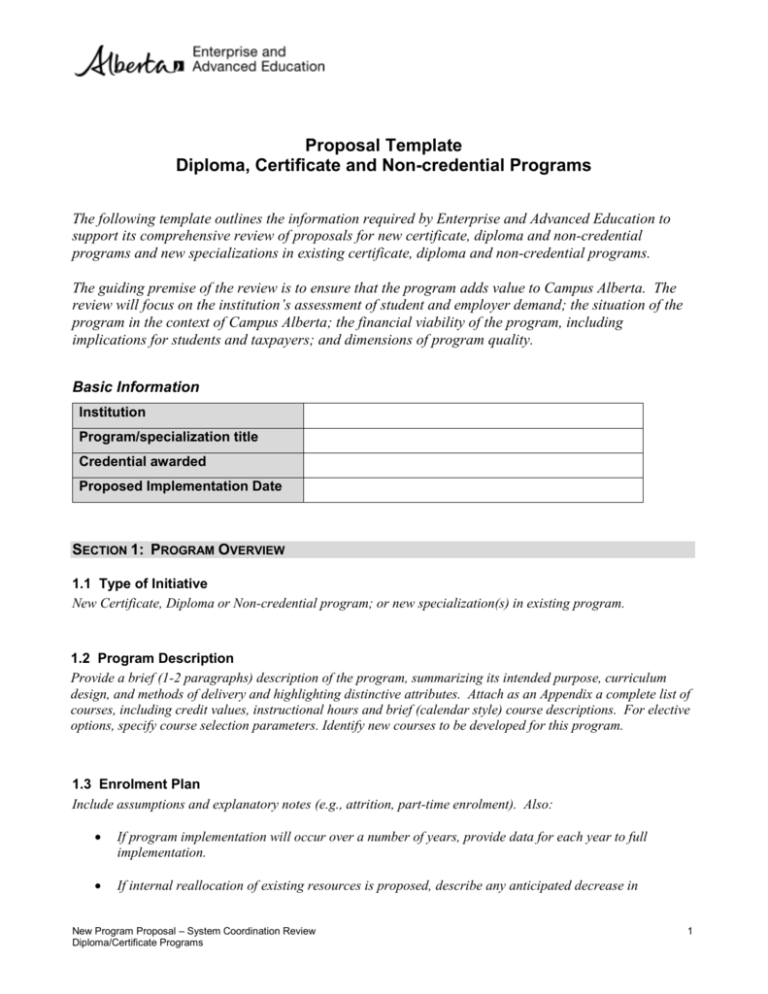Template I: New Program - System Growth
advertisement

Proposal Template Diploma, Certificate and Non-credential Programs The following template outlines the information required by Enterprise and Advanced Education to support its comprehensive review of proposals for new certificate, diploma and non-credential programs and new specializations in existing certificate, diploma and non-credential programs. The guiding premise of the review is to ensure that the program adds value to Campus Alberta. The review will focus on the institution’s assessment of student and employer demand; the situation of the program in the context of Campus Alberta; the financial viability of the program, including implications for students and taxpayers; and dimensions of program quality. Basic Information Institution Program/specialization title Credential awarded Proposed Implementation Date SECTION 1: PROGRAM OVERVIEW 1.1 Type of Initiative New Certificate, Diploma or Non-credential program; or new specialization(s) in existing program. 1.2 Program Description Provide a brief (1-2 paragraphs) description of the program, summarizing its intended purpose, curriculum design, and methods of delivery and highlighting distinctive attributes. Attach as an Appendix a complete list of courses, including credit values, instructional hours and brief (calendar style) course descriptions. For elective options, specify course selection parameters. Identify new courses to be developed for this program. 1.3 Enrolment Plan Include assumptions and explanatory notes (e.g., attrition, part-time enrolment). Also: If program implementation will occur over a number of years, provide data for each year to full implementation. If internal reallocation of existing resources is proposed, describe any anticipated decrease in New Program Proposal – System Coordination Review Diploma/Certificate Programs 1 enrolment in other programs that would result. Proposed Enrolment Total head count Year 1 Year 2 Year 3 Year 4 Year 5 Annual Ongoing 0 0 0 0 0 0 Full-Time Year 1 0 0 0 0 0 0 Full-Time Year 2 0 0 0 0 0 0 Full-Time Year 3 0 0 0 0 0 0 Full-Time Year 4 0 0 0 0 0 0 Total FLE 0 0 0 0 0 0 FLE Year 1 0 0 0 0 0 0 FLE Year 2 0 0 0 0 0 0 FLE Year 3 0 0 0 0 0 0 FLE Year 4 0 0 0 0 0 0 0 0 0 0 0 0 Anticipated No. of Graduates SECTION 2: DEMAND 2.1 Student Demand Analysis Analysis should be supported by relevant data for the region and for Campus Alberta, as might be derived from: systematic questionnaire surveys of target audiences; application and enrolment summaries and trends for similar programs currently offered by other institutions; tabulations of unsolicited student inquiries and/or expressions of interest obtained at student recruitment events; demographic projections for relevant subpopulations. 2.2 Labour Market Analysis Analysis should be supported by relevant data and placed in the context of the target occupational/regional labour market(s). Relevant data sources include systematic surveys of prospective employers; occupational supply/demand projections from government or industry sources; tabulations of job postings/‘help wanted’ advertising; surveys of recruitment and graduate employment rates of similar programs; and demographic projections (i.e. for relevant regions and sub-populations.) Describe anticipated employment outcomes. 2.3 Support Provide evidence of consultation with and approval/support from relevant professional organizations, regulatory bodies, advisory committees, employers, and/or industry. 2.4 Clinical or Work Experience If clinical or work experience is an essential part of program delivery: 2.4.1 Provide evidence that the placements will be available when needed. 2.4.2 Describe the student’s role in securing placements. New Program Proposal – Comprehensive Review Certificate/Diploma/Non-credential Programs 2 2.4.3 Explain how the institution will supervise/monitor the learning experience of students in off-site settings? 2.4.4 Identify potential employer/employee liability related to this aspect of the program, and how the institution intends to manage this liability. SECTION 3: INSTITUTIONAL AND SYSTEM CONTEXT 3.1 Institutional Strategy How does the proposed program align with the institution’s strategic priorities and the Comprehensive Institutional Plan? 3.2 Institutional Programs Explain how the proposed program fits with existing programs at the institution, and the anticipated positive or negative impacts on other programs. 3.3 Internal Review and Approval Provide a brief description of the internal review and approval process followed in developing the proposal. 3.4 Campus Alberta Programs/Initiatives Discuss the relationships (similarity, complementarity, transfer, competition) of the proposed program to other programs or initiatives in Campus Alberta and explain what the proposed program would add to the system. If the proposed program would duplicate existing programs, explain why that duplication is warranted. 3.5 Consultation Summarize the type and outcomes of consultations with other institutions offering related programs. Attach copies of relevant documents (e.g. letters, meeting summaries). Discuss the potential for inter-institutional collaboration. 3.6 Learner Pathways 3.6.1 Identify potential pathways from work to school (where applicable). 3.6.2 Identify potential opportunities for transfer/laddering into the proposed program from other institutions or other programs within the institution; and for transfer/laddering from the proposed program to other programs within the institution or at other institutions. List any formal agreements for internal or interinstitutional transfer/laddering that have been negotiated to this point. New Program Proposal – Comprehensive Review Certificate/Diploma/Non-credential Programs 3 3.6.3 Estimate the portion of graduates who can be expected to proceed to further education directly. At a later stage in their careers. What types of programs/credentials would they be most likely to pursue? SECTION 4: FINANCIAL VIABILITY AND SUSTAINABILITY 4.1 Annual Budget and Funding Sources Identify annual and one-time expenditures and annual revenue for the program in the budget tables below. If program implementation will take place over more than one year, provide estimates for each year until full implementation. Provide explanatory notes for all budget assumptions, such as inflation and per student tuition. (For proposals without significant impacts on institutional costs, revenues or enrolment, a detailed budget presentation will not normally be required (please confirm with the department). Such proposals will satisfy all of the following tests: 1. The proposal is for a new specialization in an existing program, consisting of an innovative combination of existing curricula. 2. Overall enrolment capacity in the program is maintained. 3. Excepting incidental administrative and promotional costs, no start-up or incremental operations costs are incurred.) Year 1 Year 2 Year 3 Year 4 Year 5 Annual Ongoing Revenue $0 $0 $0 $0 $0 $0 $0 $0 $0 $0 $0 $0 $0 $0 $0 $0 $0 $0 External (Third Party) Sources3 $0 $0 $0 $0 $0 $0 GOA (Identify source)4 $0 $0 $0 $0 $0 $0 Other (specify) $0 $0 $0 $0 $0 $0 Total Revenue $0 $0 $0 $0 $0 $0 Salaries, Wages and Benefits $0 $0 $0 $0 $0 $0 Materials and Contracted Services $0 $0 $0 $0 $0 $0 Other Direct Costs $0 $0 $0 $0 $0 $0 Indirect Costs $0 $0 $0 $0 $0 $0 Total Operational Costs $0 $0 $0 $0 $0 $0 Tuition and Related Fees Re-allocation from Existing Programs1 Other Internal Sources2 Operational Costs Notes: 1. Financial resources reallocated from existing programs of instruction should be estimated based on the recent cost experience of the source program(s). 2. Identify the source and duration of internal funding. 3. Identify the source and duration of external funding and outline any terms, conditions, and deliverables associated with the funding. External (Third Party) Sources might include support from other levels of government; e.g., the Government of Canada. 4. Government of Alberta sources might include future Advanced Education and Technology grant support or commitments (assumed or actual) from other departments. New Program Proposal – Comprehensive Review Certificate/Diploma/Non-credential Programs 4 One-time expenditures Amount Revenue Source Facilities $ Equipment and IT $ Curriculum Development $ Marketing and Promotion $ Faculty Recruitment and Establishment $ Library Enhancements $ Other $ Details 4.2 Impact 4.2.1 Compare the proposed tuition rate with that of similar programs in Campus Alberta. 4.2.2 Discuss the financial impact on students and the learner funding system, taking into account the costs of education and the potential debt burden relative to post-graduation earning capacity. 4.2.3 If program funding includes internal reallocation, evaluate the impact of this reallocation on the institution’s operations and overall financial position. SECTION 5: QUALITY ASSESSMENT 5.1 Institutional Capacity New Program Proposal – Comprehensive Review Certificate/Diploma/Non-credential Programs 5 5.1.1 List instructional positions that would support the proposed program, specifying position title, credential and experience requirements, and areas of expertise. Distinguish between new and existing positions; and regular and sessional appointments. Describe mechanisms (existing and planned) to develop and ensure currency of teaching skills and disciplinary expertise. 5.1.2 List instructional support positions (e.g. lab technicians, tutors) related to the proposed program. 5.1.3 Describe facilities, equipment and information resources (existing and planned) that would house and support delivery of the proposed program. 5.1.4 Discuss the anticipated impacts of the proposed program on student support services. 5.2 Curriculum Describe the process of development and validation of curriculum for the proposed program. If available, please attach external review documents. 5.3 Academic Standards List the requirements for admission and any alternate routes to admission; for residency; for academic progression; and for graduation. Compare these requirements to those for similar programs. 5.4 Learning Outcomes 5.4.1 Summarize the learning outcomes of the proposed program (e.g. career-specific knowledge and skills, employability skills). 5.4.2 Describe the consultative process with employers, industry/professional bodies or advisory groups that helped formulate these learning outcomes. 5.4.3 Provide evidence of alignment/compliance with regulatory, industry, program accreditation and professional accreditation standards relevant to the program. 5.5 Institutional Quality Assurance 5.5.1 Describe the criteria and methods for evaluating the success of the program and achieving continuous quality improvement. Include expected outcomes, key performance indicators and performance targets for the program. 5.5.2 Indicate whether a program advisory committee is planned or in place and, if so, comment on the role of New Program Proposal – Comprehensive Review Certificate/Diploma/Non-credential Programs 6 the committee in program quality assurance. RECOMMENDATION (FOR DEPARTMENT USE) Do Any Issues or Information Gaps Remain? Recommendation(s) Reviewer(s) Date Completed New Program Proposal – Comprehensive Review Certificate/Diploma/Non-credential Programs 7





